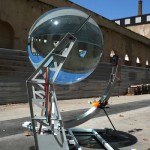The post How to Make a Manual Lens Correction in Lightroom appeared first on Digital Photography School. It was authored by Simon Ringsmuth.
The job of a camera lens is straightforward: it bends and focuses light, and it does so through the use of several curved pieces of glass that move back and forth. It sounds simple but is actually a lot more difficult than it might seem. Byproducts of all that glass are anomalies such as chromatic aberration and barrel distortion which can mar an otherwise beautiful image. Lightroom can fix these on its own to a degree, but to really take control of your pictures you can use the Manual Lens Correction panel to fine-tune your image until it’s pixel-perfect.

Understanding Chromatic Aberration
Before wading too deep into manual lens corrections, it’s important to understand what causes issues such as chromatic aberration in the first place. Different colors of light travel at different wavelengths. As a result, when the glass elements of a lens bend the incoming light, it can be quite tricky to make everything line up properly on the camera’s image sensor. This is especially prominent when shooting at the widest possible aperture since it gets really difficult to get the light to behave properly when you let so much in at once.
The result is purple and green fringes when you see hard edges in a picture. It can also produce distorted images that look either squished or puffed out in the middle. Cheaper lenses, or lenses with very wide apertures, don’t have as many glass elements to correct for these issues. It’s also why lenses like the Nikon 105 f/1.4 or Canon 85mm f/1.4 cost (and weigh) so much! They have a lot of special glass inside to correct for the problems that often happens with their less expensive counterparts.

If you don’t have a few thousand dollars to spend on ultra-sharp lenses, you can fix these image issues in Lightroom.
When you shoot in RAW, you can use the Automatic option. This does a fine job of removing purple and green fringes and fixing barrel distortion based on what it knows about the characteristics of your lens.

Click these boxes to have Lightroom automatically attempt to fix lens-related picture problems.
Nine times out of ten it does the job quite well. However, sometimes you will want to tweak things for yourself or just do the entire operation on your own. This is where the Manual option really comes in handy.
Manual Lens Correction
The Manual Lens Correction panel contains three options, each of which you can control separately.
- Distortion lets you re-shape your picture so it’s less puffed-out in the middle.
- Defringe deals with purple and green fringes at areas of high contrast, particularly with a lot of backlighting.
- Vignetting is for lightening or darkening the corners of a picture.

The Manual Lens Correction option gives you full control over lens corrections.
Distortion
This is a common issue with many lenses that isn’t always very obvious. However, once you notice it, you’ll start seeing this phenomenon all the time. Fortunately, the fix is simple. It’s usually just a matter of dragging the Distortion slider to the left or right.

Something’s not quite right here. The composition is fine but the middle is bulging out like a balloon.
As you drag the slider, you will see a grid appear over the picture which can help you get just the right value. Look for straight horizontal or vertical lines in your picture, and drag the slider until they line up with the grid.

The roof of the building gives a nice guide when correcting for distortion. It’s not quite lined up with the grid yet, but pushing the distortion slider a bit more will fix the problem.
The Constrain Crop option makes sure the final image stays within a square or rectangular boundary. If you adjust the slider too far to the right, the image can get a little too warped. However, checking this option will fix this by essentially zooming in on the picture as it’s being adjusted to avoid an extreme pincushion effect.

Final image:

Defringe
This is where you can easily correct purple and green fringes that can show up on your pictures. You can adjust the sliders manually, but my preferred way is to use the eyedropper tool to select specific areas of purple and green fringing that you want to remove.
The picture below is straight out of the camera with no lens correction applied. Notice how the edges of the bench have what appears to be slight purple and green outlines. These are caused by the light being bent and shaped by the camera lens. Once you know to look for these sorts of issues, you start seeing them all over the place!

Here’s a close-up view of the same picture. Notice the purple curve at the base of the seat and the green edges at the knurled edge that goes horizontally across the frame.

To manually correct these instances of chromatic aberration, Lightroom needs to know what range of colors you want to remove. Use the eyedropper tool to select either a purple fringe, a green fringe, or both, and then fine-tune by adjusting the sliders for Amount and Hue.

After selecting your purple and greens with the eyedropper tool, Lightroom will do its best to remove those specific colors around any high-contrast edges. You can fine-tune the defringing by adjusting the Amount and Hue sliders, but I usually find that Lightroom does a fine job just with a few clicks of the eyedropper.

When viewing the full image, you can see these instances of chromatic aberration are now gone, and the picture is much more pleasing as a result.

This operation can be extremely useful with portraits, which are often shot using larger apertures. Even if you don’t shoot close-ups for a living it’s nice to know that this simple, fast fix is available to you.
Vignetting
This option works much like the regular Vignette tool in Lightroom. You can use it to make the corners of your picture lighter or darker, depending on whether you drag the slider to the right or left.
Nearly all lenses exhibit some degree of vignetting, especially when using their widest aperture, but you can easily correct them using this tool.

Original image, straight out of the camera.
Sliding the Amount all the way to the left darkens the corners of the picture. It’s subtle but effective at drawing the viewer’s attention to the subject in the middle.

Vignette amount -100
Conversely, sliding the Amount all the way to the right makes the corners lighter. This is often useful to correct for the vignette that is inherent in many lenses at wider apertures.

Vignette amount +100
Conclusion
While you can use Lightroom’s automatic lens corrections, it’s nice to know how to correct for things like chromatic aberration, distortion, and vignetting on your own using manual lens correction. The best part is that none of these edits are permanent and you can undo your changes any time due to the non-destructive nature of Lightroom. So if you just want to try these out and see what happens, go right ahead!

The post How to Make a Manual Lens Correction in Lightroom appeared first on Digital Photography School. It was authored by Simon Ringsmuth.












































You must be logged in to post a comment.